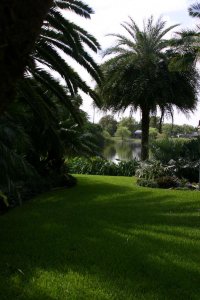Thanks for the replies guys. I will cut down on the watering to once or twice a week. It has been raining quite a bit recently anyway.
I'm assuming these were dug up out of the ground? How big a root ball if it was?
They were originally field grown. But I bought them straight from the nursery in containers that were about 4 1/2 feet in diameter. I know for a fact that they were sitting in those containers at the nursery for at least 3 weeks (I had visited before) and I expect longer. They were actually a real bargain, only $1,550 for 2 of them with delivery and installation included (they have 6 and 7 ft. clear trunk). Albert Livingstone wanted to charge me more than twice that price.
He told me he has a lot of problems with customers who over water newly installed Phoenix.
Thanks for the input, I will cut down on the watering then. But also remember that these are Phoenix Sylvestris, from the Monsoon climate of India, they are not desert palms like the Phoenix Dactiferya.
This is the most frustrating thing about gardening, it is so hard to know if you are over-watering or under-watering....
it is also important as to what kind of soil you have, and how good the drainage is
Not sure what soil I have, but I think its pretty well drained. When they installed the palms they dug craters around each palm and said I should fill them with water each day. On the big palm it takes about 8 minutes to fill it to the top with water from my hosepipe, on the littler one it takes about 5 minutes. But all that water drains out completely within 15-20 minutes (even after the sun has gone down).
Stick your finger down about 6 inches on the side where the root meets the new soil
Can't really tell if the soil is "moist" or not. It is not muddy, but its not like sand either. It just feels like regular soil, not sure if that means its moist or not. Sorry I do not know much about soil.




